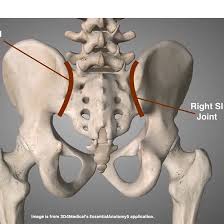Fill out form to enquire now
MRI Bilateral Sacroiliac (SI) Joints Test
The MRI Studies Bilateral Sacroiliac (SI) Joints by Medintu represent noninvasive imaging of the detailed scan in the sacroiliac joints situated at the very bottom of the spine and linked with the pelvis. The test is vital for determining arthritis, inflammation, infection, or other forms of injury in this SI joint. This scanning procedure assists in diagnosing any abnormalities that result in lower back and hip pains characterized by stiffness and unease.
With advanced MRI technology, Medintu ensures clear and precise images to help doctors identify the cause of their symptoms. MRI of Bilateral Sacroiliac (SI) Joints is safe and effective and provides a detailed study of the region without resorting to surgical modes of diagnosis.
Medintu MRI Bilateral SI Joints Test allows proper guidance during treatment related to pain and discomfort in the lower back and pelvis area. We associate with various high-graded health facilities offering optimum diagnostic services for high-quality results that ensure efficiency and good healthcare service for your condition. Book a session today and get consulted expertly by Medintu.
Why is the MRI Bilateral Sacroiliac (SI) Joints Test Performed?
An MRI bilateral SI joint test is conducted to help diagnose and monitor various conditions of the sacroiliac joints that connect the spine to the pelvis. It is quite regularly performed to investigate the cause of lower back and hip pain, inflammation, or stiffness that is unexplained. The test aids in detecting disorders like sacroiliitis, ankylosing spondylitis, osteoarthritis, infection, and injuries of the SI joints. It is also useful in the assessment of degenerative changes or abnormalities in the joints and soft tissues around them. MRI gives good detail of the bone, cartilage, and surrounding tissues, offering accurate information for a comprehensive diagnosis and treatment plan.
Symptoms Indicating the Need for an MRI Bilateral Sacroiliac (SI) Joints Test
Symptoms that may necessitate the performance of an MRI Bilateral SI Joints Test include chronic lower back pain, especially over the lower sides of the back near the pelvis; pain that is worse after standing or walking for long periods, stiffness or soreness in the hips or buttocks. There may be difficulties in moving the lower back, tenderness around the sacroiliac joints, or pain radiating down the legs. It can be indicated when these symptoms fail to improve with conventional treatment or are associated with diseases like inflammatory arthritis or trauma, MRI would help in diagnosing the exact pathology of the pain or inflammation affecting the SI joints.
Conditions Diagnosed by MRI Bilateral Sacroiliac (SI) Joints Test
The MRI Bilateral Sacroiliac SI Joints Test is performed to diagnose conditions affecting the sacroiliac joints, which involve the following:
- Sacroiliitis-inflammation of the sacroiliac joints resulting from conditions such as autoimmune diseases like ankylosing spondylitis or psoriatic arthritis.
- Osteoarthritis-destruction of the cartilage of the SI joints, causing discomfort and rigidity.
- Infections-the bacterial or fungal infections which may afflict the SI joints and cause their swelling with pain.
- Trauma or Injury: Trauma to the SI joints from accidents or falls may result in pain and dysfunction.
- Pregnancy-related Changes: During pregnancy, hormonal changes can be a cause for the loosening of ligaments around the SI joints, which can lead to instability and pain.
Preparation for MRI Bilateral Sacroiliac (SI) Joints Test
Preparation for an MRI Bilateral SI Joints Test is minimal. You will want to wear loose, comfortable clothing with no metal fasteners, zippers, or buttons because you may be asked to wear a gown. Remove all metal objects such as jewelry and watches because metal can affect the scan. If you happen to have implants, including those used in pacemakers and artificial joints, you must notify the technician. No specific dietary restrictions are usually necessary, though you may be asked not to eat or drink if a contrast dye is utilized. Comfort is key when trying to remain still during this procedure, so you should get comfortable before the actual scanning starts.
Benefits of MRI Bilateral Sacroiliac (SI) Joints Test
The MRI Bilateral Sacroiliac (SI) Joints Test offers several advantages over-diagnosing conditions of the SI joints. It will provide very detailed images of soft tissues, including muscles, ligaments, and cartilage, which are extremely important in evaluating inflammation of the joints or any other abnormalities. MRI is non-invasive, and it does not involve the use of radiation, thus making it safe for patients, even for those patients who require multiple scans. It helps diagnose various conditions such as sacroiliitis, arthritis, and infections, among other disorders affecting the joints, hence the accuracy in diagnosis and proper treatment. MRI also allows for real-time imaging, whereby doctors can identify an issue and treat it before complications set in.
Risks and Safety Considerations
MRI Studies of the Bilateral Sacroiliac (SI) Joints are usually safe, but there is a consideration of risk and safety. The strong magnetic fields of the MRI device can interfere with metal implantable devices such as a pacemaker, clip, or prosthetic and may require the patient to be informed of this when such implants are present. Pregnant women should avoid MRIs when possible. Some patients may develop discomfort from lying still for extended periods. In addition, MRI contrast agents may cause allergic reactions in some patients, so it is important to tell the healthcare provider about any allergies. Generally speaking, MRI is a very low-risk procedure when appropriate precautions are taken.
- Test Type: MRI Bilateral Sacroiliac (SI)
- Preparation:
- Wear a loose-fitting cloth
- Fasting not required
- Carry Your ID Proof
- Prescription is mandatory for patients with a doctor’s sign, stamp, with DMC/HMC number; as per PC-PNDT Act
- Reports Time: With in 4-6 hours
- Test Price: Rs.4000
Are there any risks associated with the MRI Bilateral Sacroiliac (SI) Joints Test?
MRI scans are generally safe and do not involve radiation.
What is an MRI Bilateral Sacroiliac (SI) Joints Test?
An MRI Bilateral Sacroiliac (SI) Joints Test is a diagnostic imaging procedure that makes use of magnetic resonance imaging (MRI) to produce detailed pictures of the sacroiliac joints,
Why is the MRI Bilateral Sacroiliac (SI) Joints Test done?
It assists in the diagnosis of conditions involving the inflammation, injury, infection, and degenerative diseases of the sacroiliac joints.
How Long Does the MRI Bilateral Sacroiliac (SI) Joints Test Take?
It takes approximately 30-45 minutes to get the test done depending on how intricate the procedure may be.
How Do I Prepare for the MRI Bilateral Sacroiliac (SI) Joints Test?
No special preparation is needed before the test.
Why Choose Medintu for MRI Bilateral Sacroiliac (SI) Joints Test?
Medintu ensures that MRI tests for the bilateral SI joints are done with advanced, modernized, and professionally handled machinery. Maximum patient comfort is given priority to create a smooth process without stress at any point in the procedure. All our facilities have the latest MRI diagnostic tools, which provide clear, concise results vital in diagnosis and subsequent treatment. Medintu collaborates with verified healthcare providers; the service prices are therefore very reasonable for the quality. Our customer care support will always be there for you for any kind of booking or query, making Medintu your perfect choice for MRI purposes.





